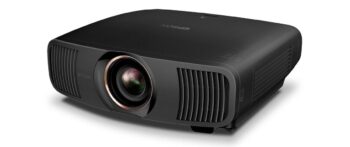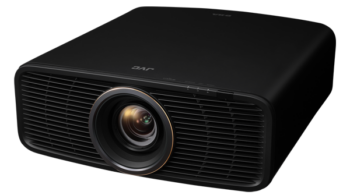

Panamorph lens systems bring high-performance, immersive, 3D-compatible digital cinema into your home – without those annoying black letterbox bars!
This is how major motion pictures look on a standard 16:9 screen or any flat panel TV. Recognize those annoying black bars?
This is how major motion pictures look in true cinema widescreen format using a Panamorph lens system on a wider 2.40:1 screen.
With a Panamorph lens, you gain over 30% more brightness and resolution and an 80% larger image. With no black bars.
THINK YOU ALWAYS GET 1080P, “TRUE HD” WITH YOUR 16:9 PROJECTOR OR FLAT PANEL?
THINK AGAIN.
Today’s big screen home theater projectors beautifully display the 16:9 aspect ratio of HD sports, documentaries, games, television programs and many small format movies for a great multimedia experience. It’s a great image, but it’s not perfect.
A 16:9 screen has a width that is 1.78 times its height. But over 70% of all major motion pictures are filmed in a wider cinematic aspect ratio of at least 2.35:1. In order for these films to fit within the smaller 16:9 screens, the image is sandwiched between two black bars. Those black “letterbox” bars represent a surprising 25% waste of the display’s claimed “1080p” resolution. Rather than taking advantage of the full 1920×1080 resolution of your flat panel or 16:9 projector, letterboxed movies are generally encoded at a mere 1920×810. What happened to the other 270 vertical rows of pixels? Over half a million pixels are lost to create those two obtrusive black letterbox bars.
Panamorph lenses paired with 2.40:1 screens provide 80% more image area than widescreen movies shown on conventional 16:9 screens of the same height. Yes, you read that right – 80% more immersive, dynamic, and involving.
16:9 FORMAT
PANAMORPH ENHANCED
PANAMORPH ENHANCEMENT PROCESS
Moving up to 2.40:1 performance means first getting a wide screen. Since movies can vary between 2.35:1 to 2.40:1 aspect ratio, we recommend a 2.40:1 screen. The next step is electronically stretching the movie in a vertical direction to use all 1080 rows of pixels – increasing the resolution by 33%. We call this electronic stretch Panamorph Mode I scaling and it’s now available with almost all projectors as an internal mode or as a feature on most high performance external image processors.
The final step is the Panamorph lens is put into place, optically stretching the image to match the vertical stretch. This returns the image to its original aspect ratio, regaining 33% resolution and dramatically increasing brightness and the overall impact that goes with it.
The images below show the step by step progression:
BASIC 16:9 SYSTEM
Above is a standard 2.40:1 image from a 16:9 projector showing black bars of unused pixels. Those black bars represent half a million pixels that are just “shut off” and a reduced picture resolution of 1920×810.
HIGH PERFORMANCE 2.40:1 SYSTEM
STEP 1
Replace the 16:9 screen with a wider 2.40:1 screen.
STEP 2
Use your projector’s Mode I scaling to vertically stretch the image electronically, using all 1920×1080 pixels and the full brightness from your 16:9 projector. This processing mode is usually a feature already built into your projector.
STEP 3
Put the Panamorph lens in place. The image is then horizontally stretched using Panamorph’s proprietary optical technology, restoring the original aspect ratio with extreme fidelity.
VIEWING 16:9 CONTENT WITH A MOVEABLE LENS SYSTEM (Panamorph models ADC1SYS, MDC1SYS, A480SYS, M480SYS)
To view 16:9 content you simply move the lens out of the way and disengage the Mode I vertical stretch scaling.
FIXED LENS SYSTEMS (Panamorph models FDC1SYS, F480SYS, FVX200)
Since the lens remains in place for all picture content, we need an additional picture processing mode referred to as “Mode II Scaling” to properly present 16:9 material. If we do not utilize Mode II scaling, we would end up with a 16:9 image that is stretched out, with improper geometry, as shown below.
Some people find this is a perfectly acceptable way to watch 16:9 content, as it fills the entire 2.35:1/2.40:1 screen. However, the geometry is incorrect, making people look fat and squat.
To display 16:9 content with the correct geometry, we engage Mode II Scaling on the projector (often referred to as 4:3 mode).
Mode II compresses the image in the horizontal direction, perfectly cancelling out the stretch of the anamorphic lens and displaying 16:9 content with the proper geometry. However, this mode reduces the resolution of 16:9 sources to 1440×1080.
SHOULD I CONSIDER A FIXED LENS CONFIGURATION?
If you are a True Widescreen fan of major motion pictures, a 2.40:1 screen and anamorphic lens are the obvious solution for max performance. The next question is how important smaller format movies and other content are to you. The most common reaction to contemplating a fixed lens solution is that smaller formats like 1.85:1 and 16:9 are shown with a lower number of pixels (1440×1080). It is instantly obvious that with a moveable lens you get it all – full 1920×1080 performance for 16:9 AND 2.35:1/2:40:1. For some people this is the holy grail and there is no need to think of other options. On the other hand, you can save both money and complexity of setup by never having to move the lens. There are several other advantages to choosing a fixed lens:
1. Brightness and resolution per unit area is the same for ALL content.
2. Calibration never changes.
3. Vertical resolution is the same for all formats – just like having a moveable lens (all content has 1080 vertical pixels).
With a moveable lens you are getting 33% more pixels in the horizontal direction for 16:9 sources (1920×1080 moveable vs. 1440×1080 fixed). While this seems dramatic, it turns out that vertical pixel count is the most important parameter in determining perceived resolution (for a number of reasons).
Consequently, a change in horizontal resolution is more difficult to see. Is such a change real? Absolutely. Is it noticeable? Remember that in a constant height imaging system your 16:9 image is, by definition, narrower than your 2.35:1 image. So while you get more horizontal pixels in that 16:9 space by moving the lens out of the way and not using Mode II scaling, those increased pixels are still in the same smaller area relative to the 2.35:1 image.
There’s a point in your field of view where you can’t even see an increase in pixels for the same image size. Consequently, the disadvantages of a fixed lens may not be as significant as you might think.












